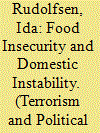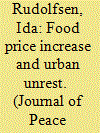|
|
|
Sort Order |
|
|
|
Items / Page
|
|
|
|
|
|
|
| Srl | Item |
| 1 |
ID:
175705


|
|
|
|
|
| Summary/Abstract |
Research on the relationship between food insecurity and unrest has a long history. The food price spikes in 2007–2008 and 2010–2011 coincided with demonstrations and incidents of large-scale violence, prompting renewed scholarly interest in the link between food insecurity and unrest. This paper reviews the literature, synthesises its main empirical findings and central explanations, and identifies four particular issues to consider to enhance our understanding of how food insecurity is related to unrest. First, there is a wide range of suggested theoretical mechanisms of how food insecurity is linked to unrest, but the empirical tests are akin. Second, there exist various notions of the independent variable, but there is a gap between the theoretical definition and measurement. Third, the focus is often on “food riots”, but whether rioting is the most likely response, and whether it is possible to separate between “food-related” unrest and other types of turmoil is unclear. Lastly, there is a challenge to address the endogenous nature of food insecurity and unrest. The paper adds to the literature by pointing to the theoretical mechanisms linking food insecurity to unrest, relating both to the type and degree of food insecurity, and how we understand and define unrest.
|
|
|
|
|
|
|
|
|
|
|
|
|
|
|
|
| 2 |
ID:
178681


|
|
|
|
|
| Summary/Abstract |
Under what conditions do increasing food prices lead to urban unrest? Existing literature suggests a positive correlation between food prices and social unrest. Meanwhile, there is a large variation in the consequences of increasing food prices, indicating that this phenomenon has a heterogeneous effect across different contexts. The theoretical focus on grievances in the existing literature appears to be insufficient for explaining the variations in outcome. This study asks whether specific features in the domestic institutional setting can explain why food-price induced grievances sometimes lead to unrest and at other times do not. Specifically, the article argues that the manifestation of unrest when food prices increase is moderated by the degree to which the state represses societal organizations. Civil and political society have the potential to channel collective dissent around food-related grievances, as these organizations provide existing mobilization structures that people can draw on to engage in collective action. Further, they can translate an individual-level grievance into a group phenomenon by politicizing the cost of food through the formulation of grievance frames. If the state represses existing societal organizations that can help aggrieved individuals engage in collective action to voice discontent – or introduces barriers to initial mobilization – this will likely reduce the possibility of unrest when food prices go up. Using institutional data from the Varieties of Democracy (V-Dem) project combined with the Social Conflict Analysis Database (SCAD), the findings suggest that repression of societal organizations decreases the likelihood of unrest when food prices rise.
|
|
|
|
|
|
|
|
|
|
|
|
|
|
|
|
| 3 |
ID:
155679


|
|
|
|
|
| Summary/Abstract |
Most studies on internal armed conflict focus on the dyadic interaction between the state and a rebel group, leaving less attention to inter-group fighting. Addressing this gap in the literature, this study argues that the interplay between economic and political inequality and weak state capacity increases the risk of non-state conflict. An empirical analysis of 178 non-state conflicts in Sub-Saharan Africa between 1989 and 2011 provides support for the theorized conditional effect, but only for the role of economic inequality. The effect of political exclusion in the context of a weak state is not confirmed, suggesting that such conditions may be more prone to violence of another kind (i.e., mobilization against the state). Overall, these findings highlight the importance of a functioning state for maintaining peaceful inter-group relations, while they also lend support to earlier research that reports divergent effects of economic and political inequalities on civil conflict risk.
|
|
|
|
|
|
|
|
|
|
|
|
|
|
|
|
|
|
|
|
|